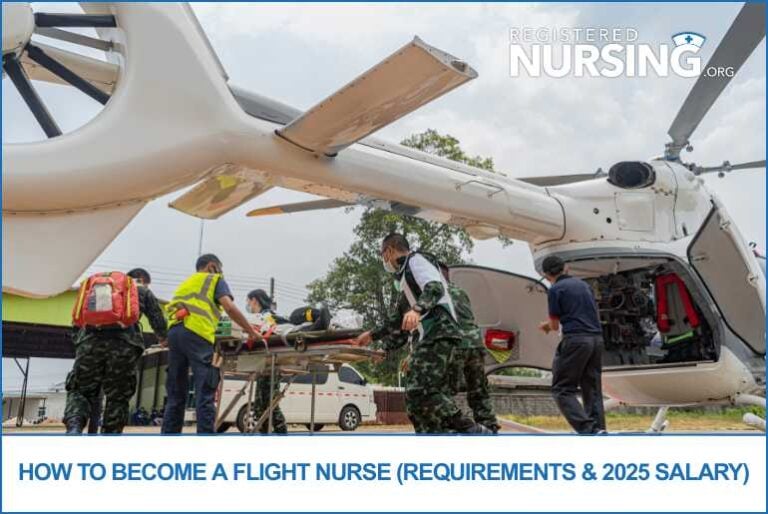How to Become a Flight Nurse (Requirements & 2025 Salary)
- What Does a Flight Nurse Do?
- Education Requirements to Become a Flight Nurse
- Certifications You'll Need
- Additional Qualifications
- Where Flight Nurses Work
- 2025 Flight Nurse Salary Expectations
- How to Start Your Flight Nurse Journey
- Professional Organizations to Join
- Ready to Soar? Here's What's Next
- Sources
- Latest Articles & Guides

Flight nursing is one of the most exciting and critical roles in emergency and trauma care. These specially trained registered nurses deliver life-saving care in helicopters and fixed-wing aircraft, often under intense conditions. With more than 550,000 air medical transports taking place in the U.S. each year (AAMS), demand for skilled flight nurses continues to rise.
As healthcare systems grow more reliant on rapid patient transport, especially in rural or underserved areas, flight nurses are becoming essential to bridging critical gaps in care. These professionals bring ICU-level treatment into the air, handling severe trauma, cardiac events, and more with skill and calm under pressure. For nurses who excel under stress and want a dynamic, high-impact path, flight nursing offers unmatched challenges and rewards.
This guide outlines how to become a flight nurse, including education and certification requirements, clinical experience, 2025 salary projections, and practical next steps to launch your career in this vital specialty.
What Does a Flight Nurse Do?
Flight nurses provide critical care and emergency treatment to patients being transported by air. They are often the first point of advanced care during interfacility transfers or trauma scene responses.
Understanding the scope of this role is crucial if you’re considering a career in the air. Flight nurses must be clinically prepared, highly adaptable, and confident in autonomous decision-making. They work with limited resources and often under intense time pressure.
Key Duties Include:
- Stabilizing patients in transit from accident scenes or hospitals
- Performing emergency interventions such as intubation, IV administration, or defibrillation
- Operating medical equipment like cardiac monitors, ventilators, and infusion pumps
- Communicating with pilots, EMS, and hospital personnel
- Documenting care and ensuring safety protocols during flight
Flight nurses must be calm under pressure, clinically skilled, and comfortable in physically demanding environments.
Education Requirements to Become a Flight Nurse
The foundation of flight nursing begins with the right education and licensure. While entry-level nursing degrees may open doors, a bachelor's degree and experience provide a competitive edge in this field.
Step 1: Nursing Degree
| Degree Type | Overview | Recommended for |
| ADN | 2-year program offering core nursing skills | Entry-level positions in non-specialized care |
| BSN | 4-year program with broader training in leadership, research, and critical thinking | Preferred for specialized and leadership roles like flight nursing |
Most flight nurse employers prefer BSN-prepared candidates due to the advanced decision-making and independence required (AACN).
Step 2: RN Licensure
All flight nurses must pass the NCLEX-RN and hold an active state nursing license. Multi-state licensure through the Nurse Licensure Compact (NLC) may offer added flexibility for travel roles.
Step 3: Gain Clinical Experience
Before flying, most programs require 3–5 years of hands-on nursing experience, ideally in critical care or trauma units. This background is essential to developing the decision-making and procedural confidence needed in flight settings.
Certifications You'll Need
Earning and maintaining advanced certifications shows employers that you are ready to perform high-acuity procedures in nontraditional care environments.
Here are the most commonly required certifications for flight nurses:
| Certification | Description | Issuing Body |
| BLS | Basic Life Support | American Heart Association |
| ACLS | Advanced Cardiac Life Support | American Heart Association |
| PALS | Pediatric Advanced Life Support | American Heart Association |
| PHTLS or ITLS | Prehospital Trauma Life Support or International Trauma Life Support | NAEMT or ITLS Org |
| CFRN | Certified Flight Registered Nurse | BCEN |
The CFRN is the gold standard certification for flight nurses and may be a condition of employment at many agencies.
Additional Qualifications
Flight nursing is not just about clinical knowledge. It requires physical fitness, emotional resilience, and excellent teamwork.
Candidates should be prepared to:
- Pass physical agility and strength tests
- Cope with high-stress, emotionally intense environments
- Communicate clearly with diverse teams under pressure
- Learn and follow aviation safety protocols
Some employers may also prefer nurses with:
- EMT or paramedic training
- Completion of a clinical ladder program (e.g., Clinical Nurse III)
Where Flight Nurses Work
Flight nurses are employed across a variety of settings, each offering unique challenges and benefits. Understanding your options can help you target the best fit for your career goals.
Common Work Environments:
- Hospital-Based Programs: Often linked to trauma centers, focusing on interfacility transfers
- Private Air Ambulance Services: Contract-based care for specialized transport
- Military or Government Agencies: Evacuation and battlefield support
- Rural Outreach Programs: Emergency response in remote or underserved areas
- Disaster Response Teams: Temporary deployment to areas affected by natural or manmade disasters
2025 Flight Nurse Salary Expectations
Flight nursing salaries vary based on geography, employer, credentials, and years of experience. In 2025, the demand for specialized nurses continues to push salaries upward.
| Experience Level | Estimated Annual Salary (2025) |
| Entry-Level RN | $70,000–$85,000 |
| Experienced Flight Nurse | $90,000–$110,000 |
| Advanced Certifications (e.g., CFRN) | $110,000–$125,000+ |
Additional salary considerations include:
- Shift differentials for nights or weekends
- On-call pay or standby rates
- Hazard pay in disaster or high-risk deployments
According to the U.S. Bureau of Labor Statistics, RNs in high-acuity specialties continue to command higher-than-average salaries due to demand and skill requirements.
How to Start Your Flight Nurse Journey
Now that you understand the requirements, here’s how to practically begin your path toward flight nursing. Mapping out these milestones will help you plan your next moves.
- Earn your BSN or plan a bridge program from ADN to BSN
- Obtain RN licensure through the NCLEX
- Gain ICU or ED experience for 3–5 years
- Pursue key certifications: BLS, ACLS, PALS, PHTLS/ITLS, and CFRN
- Prepare for the physical and mental demands through fitness training and mentoring
- Apply to flight nursing programs that match your clinical interests and geographic preferences
Case Tip:
Lena, an ICU nurse from New Mexico, began shadowing her hospital's flight team during her third year. She completed her CFRN within six months and was hired into the program full-time after demonstrating strong leadership and clinical skill.
Professional Organizations to Join
Networking with industry peers and staying informed on continuing education are essential parts of a successful flight nursing career.
Consider these respected organizations:
- Air & Surface Transport Nurses Association (ASTNA): Training, advocacy, and job boards
- Emergency Nurses Association (ENA): Professional development in emergency care
- Board of Certification for Emergency Nursing (BCEN): Certification and exam prep resources
These groups offer support systems, access to best practices, and opportunities for recognition.
Ready to Soar? Here's What's Next
Flight nursing is not for the faint of heart, but for those who rise to the challenge, it offers one of the most meaningful and respected roles in healthcare. Your path starts with education, experience, and a commitment to learning, and takes off with determination and grit.
Start by evaluating your current qualifications and making a list of milestones: Do you need to return to school for a BSN? Are you ready to commit to ICU or ED hours? Could you begin studying for the CFRN? By taking one step at a time, you can build the skills, confidence, and credibility needed to thrive above the ground and beyond expectations.
Sources
- Association of Air Medical Services (AAMS)
- American Association of Colleges of Nursing (AACN)
- National Council of State Boards of Nursing – NCLEX
- Nurse Licensure Compact – NCSBN
- U.S. Bureau of Labor Statistics – Registered Nurses
- Air & Surface Transport Nurses Association (ASTNA)
- Emergency Nurses Association (ENA)
- Board of Certification for Emergency Nursing (BCEN)
Latest Articles & Guides
One of the keys to success as a registered nurse is embracing lifelong learning. Our articles and guides address hot topics and current events in nursing, from education to career mobility and beyond. No matter where you are on your nursing journey, there’s an article to help you build your knowledge base.
Browse our latest articles, curated specifically for modern nurses.



